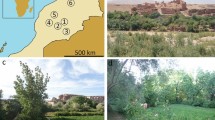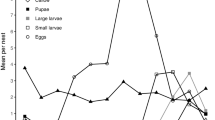Abstract.
Euglossa viridissima is an orchid bee that forms both solitary and multiple female nests, making it a suitable species for the study of factors leading to diverse degrees of sociality in Euglossines. We conducted observations in eight reused nests (where a first generation of bees had been produced) kept in artificial boxes from the Yucatan Peninsula, Mexico. Five nests were reused (reactivated) by a single female (SFN), two nests reused by a mother and one daughter (MFN1) and one nest reused by the mother and two daughters (MFN2). No single nest was reactivated by unrelated females. The number of foraging trips, their duration and the duration of cell provisioning was not different between SFN and MFN. The overall production of cells per female was not different either between both types of nest. However, in MFN although all females did lay eggs, there was a reproductive skew in favor of the mother (95 and 45% of the brood produced in MFN1 and MFN2 respectively). She showed reproductive control of her daughters through oophagy and displaying threatening behavior when the daughters tried to open a cell where she had laid an egg. Brood losses to parasites (Anthrax sp. (Bom-byliidae) and Hoplostelis bivittata (Megachilidae)) were only found in SFN which possibly reflects and advantage of MFN in this respect. Our results coupled with other studies in Euglossa, reveal that a wide range of social behaviors occur in this genus, from solitary and communal to primitive reproductive division of labor. Multiple factors involving different levels of pressure imposed by food availability and parasites may favor such a diverse range of nesting behaviors. Interestingly, female associations in E. viridissima seem a result of kin selection that is enforced by coercion from mother females on their daughters. More studies are needed to shed light upon the social organization of Euglossa and other Euglossines and on their phylogenetic relationships in order to trace the origins of eusociality in Apidae.
Similar content being viewed by others
Author information
Authors and Affiliations
Corresponding author
Additional information
Received 12 February 2008; revised 25 June 2008; accepted 17 July 2008.
Rights and permissions
About this article
Cite this article
Cocom Pech, M.E., May-Itzá, W., Medina Medina, L.A. et al. Sociality in Euglossa (Euglossa) viridissima Friese (Hymenoptera, Apidae, Euglossini). Insect. Soc. 55, 428–433 (2008). https://doi.org/10.1007/s00040-008-1023-4
Published:
Issue Date:
DOI: https://doi.org/10.1007/s00040-008-1023-4




